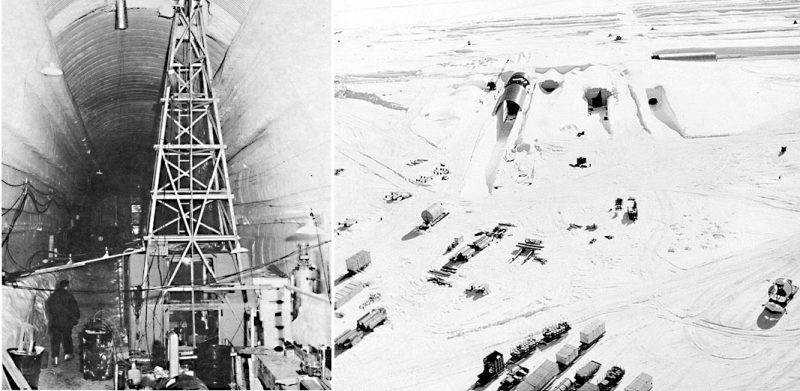Global warming was really not included in the long list of dangers to the humanity back in the early days of the Cold War; the threat of a nuclear end to known civilization was given the highest priority instead. When in 1967 U.S. authorities decided to decommission one of its military bases built in the Greenland ice sheet, the whole structure was simply left abandoned, the perpetual snowfall turning it into an icy tomb. The military base, called Camp Century, was opened in 1959 as a secret site to analyze the feasibility of nuclear missile deployment from the Arctic to counter the Soviet Union’s growing nuclear ambitions.
However, a recent study suggests that the camp site is a potential threat to the surrounding ecosystem due to the rapid melting of the ice sheets covering the infrastructure, courtesy of global warming. The researchers suggest that the whole structure could re-emerge as early as the end of the century (quite ironic, given the camp’s name) potentially releasing a lethal dose of radiation that could devastate swathes of lands surrounding the cold war base.
The detailed study was published in Geophysical Research Letters, which is a renowned journal of the American Geophysical Union; it lays down the analysis on the threats of Camp Century once it is fully exposed to nature. The research team analyzed the inventories of the nuclear waste once housed in the camp and deployed high-tech NASA equipment to scan the underground (or under the ice to be more precise) infrastructure. This gave the scientists a very clear and daunting picture of the potentially radioactive monster about to wake up thanks to the inadequate planning at the time of its abandonment by U.S and Danish authorities.
The United States had signed a joint defense treaty with the Danish government in 1951 to defend Greenland from any Soviet incursion, and this provided the U.S. an opportunity to build an underground research facility to test the feasibility of a nuclear missile launch from the Arctic towards Soviet territory. The project was called Project Iceworm and was kept hidden from the Danish authorities; the plan was to build miles of tunnels underground, facilitating a launch of some 600 nuclear missiles in case an all-out nuclear war broke out in the region. However, a few years later the project was deemed unnecessary, and the whole plant was abandoned along with any and all nuclear and radioactive waste present within the site at the time. Both the U.S. and Danish government officials were fully aware of the fact that one day the ice sheet could melt, exposing nature to the harmful nuclear material. They, however, deemed it to be not an immediate threat and decided to overlook the environmental issue.
According to Willian Colgan, who led the study and is a climate and glacier scientist at York University, Toronto, this new kind of waste management could trigger a whole new breed of political challenge. The responsibility of cleaning up the mess could lead to heated debates and perhaps political rifts due to the cost of removal and hazardous nature of the radioactive material buried under the ice.
Jessica Green, who is a political scientist and specialist in international environmental law at New York University, suggests that the matter of cleaning up the radioactive waste could prove to be a highly complex issue considering the very location of the site.
She added that although international law is very clear in terms of the responsibility for the prevention of future hazardous waste, it is rather ambiguous and often vague when it comes to holding a single unit responsible for the measures required improve the situation.
Despite the fact the camp was built and operated by the U.S, it was built on Danish soil, and although Greenland is technically Danish territory, it is currently a self-governing entity; all of this geographical entanglement could potentially hinder any steps towards the removal of hazardous material.
The question was never if, but when the ice would melt, uncovering the infrastructure, said James White, a climate scientist from the University of Colorado. Mr. White is not associated with the study. He asserted that the U.S. authorities and the experts working for them at the time were fully aware of the dangers such a facility could pose if left unattended; however, they decided to overlook the matter, thinking the exposure could take hundreds if not thousands of years. However, White explained, the growing rate of global warming literally pushed the gas pedal to the floor and accelerated the rate of ice melt, hence making the real threat only a few decades after the burial of the site.
